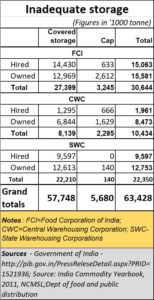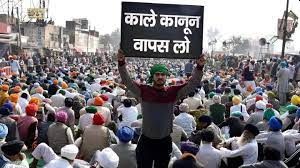https://www.moneylife.in/article/why-we-need-more-sensible-laws-to-stop-exploitation-of-famers/65228.html
The farmer remains terribly exploited
Why the three farm laws need to be repealed and more sensible farmer friendly laws put in place
RN Bhaskar
 The farmers called for a Bharat Bandh on 27 September 2021. It was largely successful. What is amazing is that despite the brute force with which the government tried to break the farmer protests, the farmers remain defiant. They want the three farm laws repealed (https://www.moneylife.in/article/the-fight-is-no-longer-between-the-good-and-the-bad-but-between-the-corrupt-and-the-rapacious/62370.html) .
The farmers called for a Bharat Bandh on 27 September 2021. It was largely successful. What is amazing is that despite the brute force with which the government tried to break the farmer protests, the farmers remain defiant. They want the three farm laws repealed (https://www.moneylife.in/article/the-fight-is-no-longer-between-the-good-and-the-bad-but-between-the-corrupt-and-the-rapacious/62370.html) .
The Modi-government cussedly refuses to do so. The Supreme Court has stepped in and has stayed the operation of the three laws. In all probability, the laws will be struck down by the Supreme Court, or they will be repealed just before the next national elections.
Too much is at stake for the farmers.
The trouble is that the farmers themselves do not know why the laws must be repealed. In fact, many of the farmer leaders may not like this article – and most certainly politicians across party lines too. The fact is that most farmers have been used and abused.
Despite platitudes, most politicians do not want small farmers to become financially independent. That would reduce their ability entice farmers with doles.
Exploitation
The first two tables tell the story of how little farmers earn. The first table gives farmer incomes state wise. The most privileged are the politically well connected, and cossetted, states of Punjab and Haryana. The most progressive are cash crop growers like those who grow spices and rubber (and even sugarcane, but more on this later). That can explain (largely) why farmers in Punjab, Haryana and Kerala remain richer than farmers elsewhere.
States like Maharashtra and Karnataka have encouraged sugarcane growers, who get better returns than other farmers, In Maharashtra, however, even though there is less water, governments have permitted sugarcane acreage to increase by over 125% between 1990 and 2020. So other crops were denied water, and irrigation.
But Uttar Pradesh has seen the worst exploitation of farmers. They are not allowed to form cooperatives – either for milk or for sugarcane. For milk, the farmer gets around Rs.10 per litre less than his counterparts in other states. This is despite UP being the largest milk producer in the country. Last week, the state government, possibly with an eye on state elections, agreed to give the farmers Rs.25 per quintal more for the sugarcane growth. Even this is a pittance. The political setup in UP prefers keeping the farmers on doles, so that their votes could be ‘captured’.
The second chart is about how little farmers earn. As this table from Nabard shows, the farmer earns quite a bit working as a wage-labourer. That is more remunerative than cultivating his own field. Wage labour contributed to almost half the total household income.
And do bear in mind that this is the average for all farmers. If small farmers were to be classified separately, the figures for cultivation become half the figures shown here. Small farmers – who comprise almost 80% of all farmers – were brutalized.
 Watch the earning from livestock. Even a single cow can generate profit (all income less expenses) of Rs.100 daily for 300 days a year, provided it is given decent cattle feed. That should have generated an income of Rs.2500-3000 per month. But, as said earlier, UP’s farmers get among the lowest prices for milk (https://www.moneylife.in/article/who-is-responsible-for-keeping-farmers-in-bihar-and-uttar-pradesh-poor/64639.html).
Watch the earning from livestock. Even a single cow can generate profit (all income less expenses) of Rs.100 daily for 300 days a year, provided it is given decent cattle feed. That should have generated an income of Rs.2500-3000 per month. But, as said earlier, UP’s farmers get among the lowest prices for milk (https://www.moneylife.in/article/who-is-responsible-for-keeping-farmers-in-bihar-and-uttar-pradesh-poor/64639.html).
Rice and wheat
The three farm laws talk about farmers selling to mandis and commodity markets. But they keep silent on the central government’s wheat and rice procurement policies. Much of the rice and wheat procurement – the only crops that are procured by the government year after year – clearly favour Punjab and Haryana (see chart). On paper, the government’s arm, the Food Corporation of India (FCI) which oversees procurement of rice and wheat, does this work in partnership with other state procurement agencies.
One thing becomes quite clear when you look at the figures – which are the average annual figures for the period between 2014-15 to 2019-20.
 Farmers in Punjab could ensure that over 85% of its rice and 69% of its wheat got picked up by government procurement agencies. Similarly, farmers in Haryana saw 78% of their rice and 67% of their wheat being procured.
Farmers in Punjab could ensure that over 85% of its rice and 69% of its wheat got picked up by government procurement agencies. Similarly, farmers in Haryana saw 78% of their rice and 67% of their wheat being procured.
Since procurement prices of rice and wheat have gone up year after year without fail, these farmers faced little market price risk. In fact, the prices in India are higher than international prices. So, farmers in these two states, who are extremely well-aligned politically, have little to worry about – free water, subsidised electricity, remunerative and guaranteed prices. Marginal farmers in Punjab and Haryana may get left out. But overall, the farmers there are a pampered lot.
Many farmers in these states are known to cheat despite these benefits. They will persuade the procurement officers to purchase their crop as A grade grain, even if it is B or C grade. The officials usually do so, after their palms have been greased.
That is one reason why, FCI allows grain to rot outside the warehouses so that audit of the grain procured is never possible.
Too little storage, too much procurement
There is another problem, which procurement officials see as an advantage. There is little storage capacity, and too much of procurement.
Consider the two tables that follow. One is the estimated storage capacity in India. Unfortunately, the government has not given out the latest figures, and the figures in the chart have been culled largely from data collated in 2011.
The next chart is about WDRA approved storage – possibly incremental storage – as of 2011. The WDRA (the Warehousing Development Regulations Act) was promulgated in 2010 (https://asiaconverge.com/2017/08/is-wdra-a-functioning-organisation/).
 The three laws enacted by the government do not talk about improving warehousing – critical for preservation of farm crops – whether they are grains, or vegetables and fruit. All crops require warehouses – and different kinds of crops need different temperature and humidity controls for them. In fact, the government has kept silent about warehouses, and has not breathed a word about strengthening the WDRA, which is in charge of ensuring that every farmer’s produce is picked up.
The three laws enacted by the government do not talk about improving warehousing – critical for preservation of farm crops – whether they are grains, or vegetables and fruit. All crops require warehouses – and different kinds of crops need different temperature and humidity controls for them. In fact, the government has kept silent about warehouses, and has not breathed a word about strengthening the WDRA, which is in charge of ensuring that every farmer’s produce is picked up.
 The idea was to have a warehouse without 5 or 10 km from almost every farm. This way, the farmer could deposit his produce in the designated warehouse – depending on the type of crop he grows. At times the farmer would grow the crop which could be picked up by the warehouse in his neighbourhood.
The idea was to have a warehouse without 5 or 10 km from almost every farm. This way, the farmer could deposit his produce in the designated warehouse – depending on the type of crop he grows. At times the farmer would grow the crop which could be picked up by the warehouse in his neighbourhood.
The warehouse evaluates the crop, grades it, and gives the farmer a dematerialized warehouse receipt. The farmer takes this receipt to the bank and can encash it based on prices ruling on commodity exchanges.
The WDRA was meant to break the need for mandis to be the sellers, but saw their role primarily as aggregators. It decentralised the farming business into professional roles, reducing the need for political intermediaries.
The three farm bills do not touch that.
Now look at the numbers. India produced around 111 million tonnes of rice each year (average) and around 98 million tonnes of wheat (average) Together they account for over 210 million tonnes.
Now compare these numbers with the storage capacity.
Unfortunately, the WDRA does not reply to emails, or provide clear figures about the state of warehousing in the country. But a document of 2010 (https://wdra.gov.in/documents/32110/38835931/RegisteredWarehouseList.pdf/32f79ca5-a287-6713-1199-c44466699225) shows that as of 10 July 2020, the WDRA had registered warehouses with a combined capacity of 95,07,621 tonnes (or 9.5 million tonnes). Yet another document gives the figure of 14 million (see chart). Even if one takes the higher figure, the combined storage of 63 million tonnes, added to 14 million tonnes would give the country barely 80 million tonnes.
So, you have grain production which stands at 200 million tonnes and storage at just 80 million tonnes of just rice and wheat. Procurement (hence guaranteed prices) accounts for only 30-35% of this quantity. So, 65% of the crop must be sold at distressed prices. The middleman is well in control. Political favouritism continues as before. In fact, as production volumes of rice and wheat have increased this year as well, the power of playing favourites becomes more potent.
The government does not dare use market mechanisms to reduce production volumes. It dares not tax water or electricity to wean farmers away from rice and wheat. It is thus leading farmers up a cliff till there is no going further. This must stop.
New laws needed
In order to make agriculture healthier, it needs to do many things. None of them are addressed by the three farm laws.
- It must wean away farmers from rice and wheat production.
- It must take all the warehouses (of FCI, SWCs and CWC) and put them with the WDRA. That will enable the WDRA to decide which warehouse is best suited for which crop.
- All procurement by the FCI and state procurement agencies must now be done through the commodity markets. That will ensure that all farmers get an equal opportunity to sell their grain through commodity markets. To protect prices, the government may purchase grain from commodity markets, then give them to the FCI and state procu8rement agencies for distributions to public distribution shops (PDS) or ration stores. The procurement by the government creates a benchmark pricing which middlemen will have to accept, else they will lose their farmer customers who will sell to warehouses and through commodity exchanges instead.
- Permitting contract farming without giving farmers the right to lease out their land can drive them from the village middleman to corporate middlemen like Reliance, Adani, or ITC. The small farmer may be wooed initially but, as has happened in most countries, large organisations often compel farmers to sell their produce at low prices. The farmer must have a way out. One way out is to allow him to lease out his land to a bigger player. This way, the farmer gets a minimum rent equal to or more than the value of his cultivation each month. He will continue to augment it with wage labour. But he retains ownership of his land, which he does not want to lose. When he feels confident enough, he will resume farming. Give the farmer the choice to produce independently, or produce on contract, or give his farm on lease for at least five years. The other party needs this time span because it must first improve the land and make the required investments. That will take around a year to do so. It will then try recoup the cost of investments in the remaining four years. This way, big players can bring in technology (hydroponics is one good example — https://asiaconverge.com/2018/06/hydroponics-could-be-the-future-of-farming/). Small farmers cannot make such investments which can make even small farms profitable.
- Focus on Farmer Producer Organisations (FPOs) as aggregators, which can collect small quantities from many small farmers and sell large quantities to warehouses, which act as super aggregators for onward sale through commodity exchanges. Most importantly, set up super FPOs – like a federation – for each crop so that they can then, like Amul, set up (directly by themselves or in association with private parties) processing and marketing facilities. Eventually, as Verghese Kurien often said, the farmer is the most important player in the food chain. His profit must therefore be the largest. The government has forgotten the relevance of that vision.
- Under no circumstances must the government procure grain or agricultural crop directly from farmers. Just as the government has made assessments faceless for the income tax department, it must make procurement faceless, and only through commodity markets.
- Give the WDRA more powers and time bound targets.
- Mandate a minimum statutory price for milk, so that the farmers of Uttar Pradesh and elsewhere do not suffer. Allow agricultural subsidies and grants to be transferred from the centre to the states only for cooperatives, not for state government departments.
- Reduce the acreage of sugarcane in water starved regions like Maharashtra.
These are things that the three laws don’t do.
At present the three laws tinker with agricultural produce in such a manner that state politicians are cut off from milking farmers, but the central government is permitted to reward politically aligned farmers who grow rice and wheat. This allows the centre to make money and dispense favours, yet attempting to emasculate state political parties. This one-sided approach will just not do.
The three laws must therefore go.










































COMMENTS